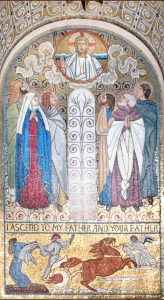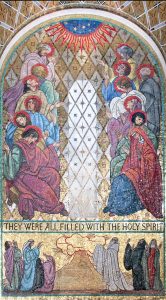
Where, O death, is your victory?
Where, O death, is your sting?
But thanks be to God who gives us the victory through our Lord Jesus Christ.
– 1 Corinthians 15:55, 57
As we enter the season of Easter, we reflect on the Glorious Mysteries during this celebration of Christ’s triumph over sin and death, rejoicing in the new life that we have been given. The Glorious Mysteries are depicted in multiple places in the Basilica, including the Great Upper Church and the Rosary Walk and Garden.
 First Glorious Mystery: The Resurrection
First Glorious Mystery: The Resurrection
In the Great Upper Church, each of the Glorious Mysteries is depicted with its Old Testament foreshadowing. The Resurrection Chapel depicts the angel’s appearance to Mary, Martha, and the Blessed Mother, telling them of Christ’s resurrection. Jesus, in all his glory, rose from the dead in triumph, defeating sin and death, and securing eternal life for those who believe in him.
Matthew 28:5-6 says:
Then the angel said to the women in reply, “Do not be afraid! I know that you are seeking Jesus the crucified. He is not here, for he has been raised just as he said. Come and see the place where he lay.”
The portrayal of the resurrection is accompanied by an image of Joseph being pulled out of the cistern (Genesis 37:12-28).
Second Glorious Mystery: The Ascension
After rising from the dead, Jesus spoke to the disciples for the final time and ascended to take his seat at the right hand of the Father. In the Great Upper Church depiction, this is paralleled by a depiction of Elijah, riding to heaven in a chariot of fire (2 Kings 2:1-15).
The Ascension is described in Mark 16:19-20:
So then the Lord Jesus, after he spoke to them, was taken up into heaven and took his seat at the right hand of God. But they went forth and preached everywhere, while the Lord worked with them and confirmed the word through accompanying signs.
The Ascension is significant because it marked that Jesus’ ministry on earth is done, and he is now in heaven to preparing a place for us. Yet, we are not left alone.
Third Glorious Mystery: Descent of the Holy Spirit
After his ascension, Jesus sent the Holy Spirit to guide his followers and be present with them until his return.
Acts 2:1-4 describes:
When the time for Pentecost was fulfilled, they were all in one place together. And suddenly there came from the sky a noise like a strong driving wind, and it filled the entire house in which they were. Then there appeared to them tongues as of fire, which parted and came to rest on each one of them. And they were all filled with the holy Spirit and began to speak in different tongues, as the Spirit enabled them to proclaim.
The Old Testament parallel shown is that of Moses on Mt. Sinai, receiving the law. Just as the law enabled the Israelites to live by the Old Covenant, the Holy Spirit enables us to live by the New Covenant. The Descent of the Holy Spirit is also depicted in the Descent of the Holy Spirit Dome.
Fourth Glorious Mystery: Assumption of Mary
Just as Solomon brought the Ark of the Covenant to the Temple (1 Kings 8:17-21), Mary, as the Ark of the New Covenant, was brought to heaven to dwell where Christ is.
Pope Pius XII said in his apostolic letter Munificentissimus Deus:
Now God has willed that the Blessed Virgin Mary should be exempted from this general rule [death]. She, by an entirely unique privilege, completely overcame sin by her Immaculate Conception, and as a result she was not subject to the law of remaining in the corruption of the grave, and she did not have to wait until the end of time for the redemption of her body.
Fifth Glorious Mystery: Coronation of Mary
In the Old Testament, Bathsheba received honor from her son Solomon (1 Kings 2:19); similarly, Mary receives honor from her son Jesus.
Revelation 12:1 is traditionally believed to refer to the Coronation of Mary:
A great sign appeared in the sky, a woman clothed with the sun, with the moon under her feet, and on her head a crown of twelve stars.
This scene is not only depicted in the Glorious Mysteries Chapels and the Rosary Garden – it is also the subject of the massive mosaic in the West Apse of the Upper Church, The Woman Clothed with the Sun.





